Cathedral
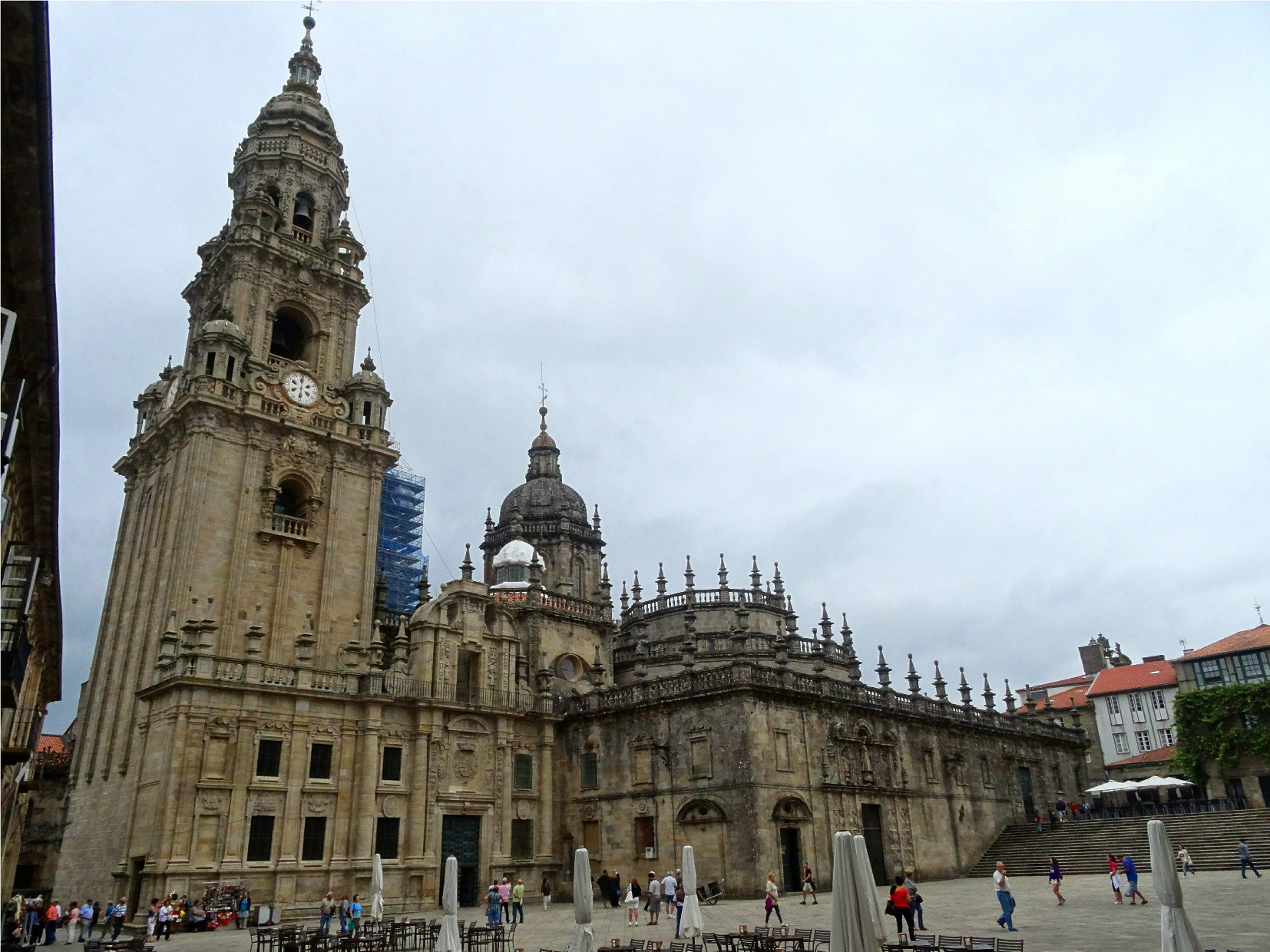
Santiago de Compostela is located in Galicia in north-western Spain and is famous for its Cathedral, which was built on the shrine of Saint James, (son of Zebedee) one of the Apostles of Jesus. The cathedral is the destination for Catholic pilgrims who complete the Way of Saint James, a pilgrimage which originated in the 9th century and is the third most popular pilgrimage for Christians/Catholics.
According to legend, it was Saint James who brought Christianity to the Iberian Peninsula around 44 AD. On his return to Jerusalem he was beheaded, but his remains were brought back to Spain where he was buried. His tomb was maintained until the 3rd century when, as a result of Roman persecution, it was abandoned and forgotten. In 814 the tomb was rediscovered and a chapel was built on the site by King Alfonso II of Asturias and Galicia (791-842). The first church was built on the site in 829, and this was enlarged in 899. In 997 the church was destroyed but Saint James’s tomb survived, although the Gates and bells were taken to the Aljama Mosque at Cordoba.
Constructed mainly of granite, the present cathedral was started in 1075 during the reign of Alfonso VI of Castile (1040–1109); although construction was halted a number of times and the last stone was laid in 1122, and was consecrated in 1128. The cathedral underwent a number of expansions in the 16th, 17th and 18th centuries. Despite its Baroque facade, the present cathedral of Santiago de Compostela is predominantly Romanesque; in fact, one of the finest Romanesque churches in Spain.
Each of the facades is known not only by its orientation but also by name. The West façade, which has become the symbol of the city is known as the Obradoiro and overlooks the Obradoiro Square. This has undergone a number of developments over the years, with the current Baroque façade being constructed in the 18th century. The tower to the right (The Bell Tower) represents the mother of Saint James, whilst the one on the left (The Rattle Tower) represents Zebedee, his father. In the centre are statues of Saint James and below him are his two disciples.
The two towers are of medieval origin with the first part of the tower being built in the 12th century, but in the 15th century several modifications were made. They were remodelled in the latter half of the 17th century. Due to a tilt being detected in their structure, the towers had to be reinforced with buttresses, between 1667 and 1670. Known as the Torre das Campás they reach the height of over 75 metres.
During 2014 (when these photographs were taken) the cathedral was undergoing repair works to eradicate a fungus which was growing on the façade, which meant that parts were covered in scaffold and hoardings.
The stairway leading to the entrance is in the Renaissance style and was constructed in the 17th century. This surrounds the entrance to the 12th century Romanesque crypt which was part of the old cathedral constructed by Master Mateo; the most important artist/builder of the Romanesque period.
The North façade or da Acibecharía contains a Romanesque portal built in 1122. This portal was demolished following a fire in 1758, although some of the sculptural pieces were saved and were placed on the South façade. The new North façade was designed in Baroque style but was finished in the neoclassical style in 1769, although it retained some aspects of the baroque. At the top of the façade is an 18th-century statue of Saint James with King Alfonso III and King Ordoño II at his feet.
The South façade or das Pratarías is in Romanesque style built between 1103 and 1117 and is the only Romanesque façade to remain. This façade has two doors with figures of prophets and the Apostles. The façade contains many figures which were brought from the North façade in the 18th century. At its corner stands the Clock Tower (also called Torre da Trindade or Berenguela) the construction of which was believed to have begun in 1316 as a defensive tower. This was subsequently added to and between 1676 and 1680 two additional floors were added with its cupola and a lantern rising to 75 metres. The clock faces on each side were added in 1833.
The East façade or da Quintana has two gates: the Porta Real or Royal Gate and the Porta Santa, the Holy Gate. The Porta Real, in the baroque style, was begun in 1666 and completed in 1700. Located above the door is the Royal Coat of Arms as it was this door which was used by the Kings of Spain to enter the cathedral, hence the name. The Holy Door is only opened in the year when St James's Day (25th July) falls on a Sunday. Above the door are statues of St James with his disciples Athanasius and Theodore on either side of him.
Inside the cathedral, visitors find the nave, with two lateral aisles, a wide transept and a choir with radiating chapels. The interior is 97 m long and 22 m high. It still has the original barrel-vaulted cruciform Romanesque interior.
Behind the western façade is the 12th-century Portico da Gloria (The Glory Portico). It stems from the Romanesque period and was built between 1168 and 1188 by Master Mateo.
The barrel-vaulted nave and the groin-vaulted aisles consist of eleven bays, whilst the transept consists of six bays. The Piers are clustered and flanked by semi-columns, three of which carry the cross vaults of the side aisles and the truss of the arched vaults, whilst the fourth goes to the spring of the vaults.
The Transept contains the giant Botafumeiro which is suspended under the dome. Measuring 1.60 m in height and weighing 80 kg it is the world’s largest Botafumeiro. On important religious days it is attached to the pulley mechanism, filled with charcoal and incense and is swung across the transept; a custom which is believed to have originated more than 700 years ago to cover the smell of the many unwashed pilgrims who arrived at the cathedral at the end of their pilgrimage. The original Botafumeiro was made of silver but this was removed by French troops in 1809 and was replaced with an iron one, the current one is silver plated and was installed in 1851.
The Church of the Corticela is dedicated to the Virgin Mary. Her statue holding Jesus in her arms and wearing a large crown presides over the chapel which is divided into three naves. Built in the 9th century it was originally independent of the cathedral and was used by the Benedictine monks. In the 13th century it was refurbished and was later connected to the cathedral’s transept by a corridor.
One of the main attractions has always been the tomb of Saint James, although prior to an English invasion, the remains of Saint James were hidden. These were lost in 1700 and remained lost until they were found in 1879 during the course of building work. Three skeletons were found which were believed to have been Saint James and his two disciples. The one of Saint James was confirmed by the fact that a fragment of his skull was held by a church in Tuscany which fitted a gap in the skull of one of the skeletons.
The remains of the three skeletons are in a silver casket over a marble altar in the apostolic crypt below the High Altar of the cathedral. Rising above the altar is a large baldachin with a highly decorated statue of Saint James dating from the 13th century. Behind the altar is a narrow passage which pilgrims can use to gain access in order to kiss the saint’s mantle.
Today the Way of Saint James has a number of routes with hostels established to cater for the thousands of pilgrims who travel to Santiago de Compostela each year.
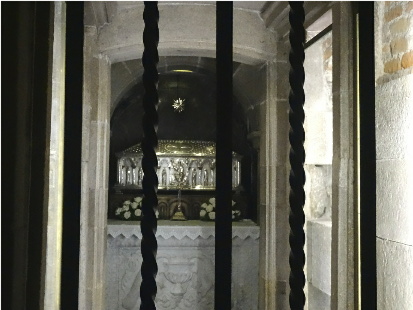
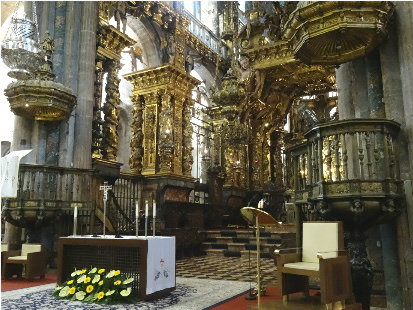

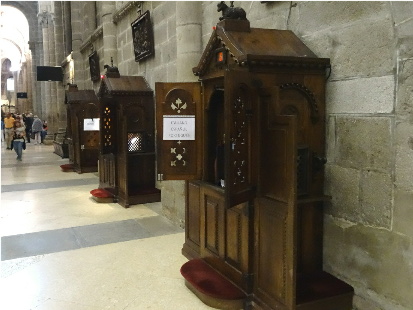




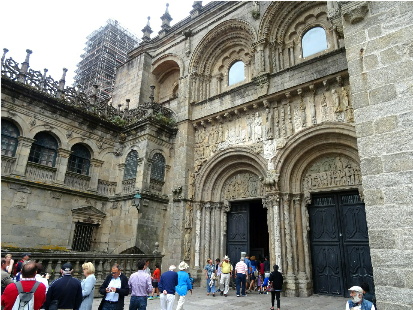
To see more photographs and take a virtual tour of the site click on the photoshow below.
